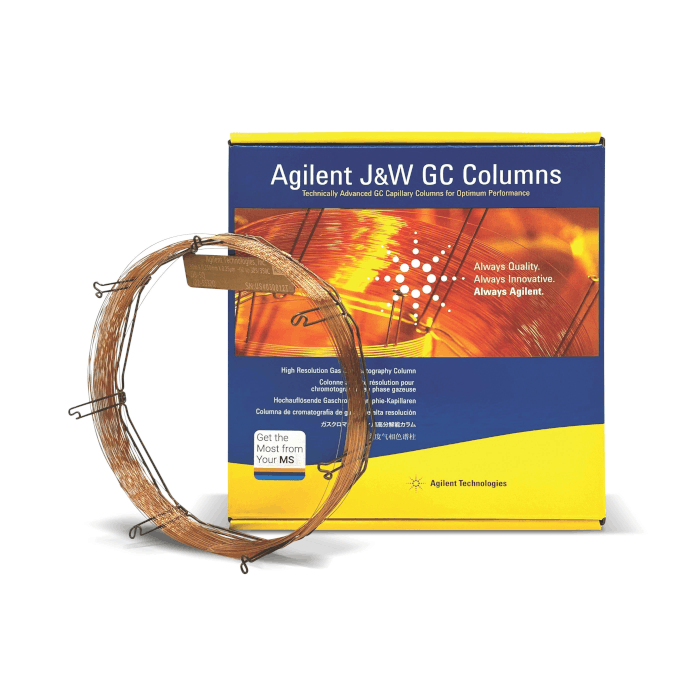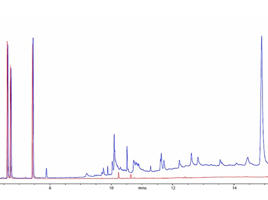Gas chromatography coupled with mass spectrometry (GC/MS) is central to regulatory compliance and product safety testing across fields such as environmental monitoring, pharmaceuticals, and food safety. However, trace-level analysis in complex matrices places considerable demands on GC columns. High temperatures and heavy sample matrices accelerate stationary phase degradation, leading to column bleed, baseline drift, retention time instability, and reduced data quality.
The Agilent J&W 5Q series was developed to address these analytical challenges by providing enhanced thermal stability, low-bleed performance, and ultra inertness. This article demonstrates its performance in three common application areas: pesticide analysis, semi-volatile organic compound (SVOC) determination, and extractables and leachables (E&L) testing.
Retention Time Stability in Trace-Level Pesticide Analysis
Trace-level pesticide analysis is essential for regulatory compliance but presents significant challenges, as methods often need to detect hundreds of analytes at varying concentrations within complex sample matrices. To withstand the high temperatures sometimes required to elute matrix components – and to reduce peak tailing of active analytes – thermally stable, ultra-inert columns are critical.
Accurate retention times are particularly important in pesticide testing, where mass spectrometer detectors operating in selected ion mode (SIM) or multiple reaction monitoring (MRM) mode depend on time segment windows. Retention time drift caused by column bleed can shift analytes outside these windows, necessitating frequent method re-optimisation. While some bleed is expected, a significant baseline rise indicates stationary phase breakdown, which can cause retention time instability.
Enhanced column stability helps to mitigate these issues. Columns such as the DB-5Q and HP-5Q are designed to resist thermal and matrix stress, maintaining retention times over extended use. Retention Time Locking (RTL) adds another layer of reproducibility by adjusting flow or pressure so that retention times remain consistent across instruments and columns with equivalent selectivity. With just a single calibration injection, acquisition windows can remain fixed, even when columns are replaced.
In a comparative study, a pesticide mix analysed on a DB-5ms UI column with RTL locked to chlorpyrifos-methyl was repeated on a DB-5Q column under identical conditions. The DB-5Q exhibited equivalent selectivity and full compatibility with RTL libraries, while also producing lower bleed at elevated temperatures (Figure 1).


Figure 1: Comparison of DB-5Q and DB-5ms UI columns: similar selectivity for pesticide compounds and reduced bleed at the upper temperature limit of the chromatographic method using DB-5Q. [1]
To assess robustness under real-world conditions, a heavy soil matrix was diluted in dichloromethane and analysed across multiple thermal cycles. As shown in Figure 2, the DB-5Q column maintained stable retention times through more than 200 consecutive soil matrix injections, with %RSD values for pesticide standard replicates remaining below 3%. Its enhanced thermal stability not only limited baseline rise at higher temperatures but also reduced spectral interference, resulting in high library match factors above 95.


Figure 2: Pesticide checkout mix analysed before and after 200 soil matrix injections on an Agilent J&W DB-5Q GC column. [1]
Enhancing Reliability in Semi-Volatile Organic Compound (SVOC) Analysis
EPA Method 8270 specifies a list of more than 200 semi-volatile organic compounds (SVOCs) identified as pollutants in environmental and industrial matrices. Many of these compounds are chemically active and prone to interactions within the instrument flow path, which can degrade data quality. When method performance criteria are not met, corrective maintenance is required – often involving liner replacement, column trimming, or complete column replacement – resulting in instrument downtime.
Polysiloxane-based stationary phases are widely used for SVOC analysis but can exhibit limitations at elevated temperatures. Under such conditions, the polymer may undergo “backbiting,” releasing stable ring structures that increase baseline noise and interfere with spectral quality. These effects compromise signal-to-noise ratios, peak integration, and spectral matching, particularly for trace-level analytes.
The DB-5Q minimises these effects, making it well suited for analysing low-concentration compounds at elevated temperatures. Figure 3 highlights the S/N ratios of late eluting SVOCs demonstrating its effectiveness for this method.


Figure 3. SVOC standard analysed at 10 pg on column, collected by dMRM/scan mode with the extracted MRMs. [2]
Improved peak symmetry is also observed for active compounds. For example, 2,4-dinitrophenol, which exhibits significant tailing on conventional columns, is resolved on the DB-5Q with sharper peaks and improved signal-to-noise ratios (Figure 4).


Figure 4. Integrated peak of 250 pg on-column 2,4-dinitrophenol, analysed on a conventional 5 ms-type column X (A) and an Agilent J&W DB-5Q GC column (B). [2]
By combining ultralow bleed, chemical inertness, and high thermal stability, the DB-5Q exceeds EPA Method 8270 requirements. Its stable baselines under extended high-temperature operation and improved peak shapes for active analytes reduce spectral interferences, enhance compound identification, and extends maintenance intervals to improve laboratory productivity.
Overcoming Column Bleed Challenges in Extractables and Leachables Testing
Extractables and leachables (E&Ls) analysis is a critical part of pharmaceutical development, ensuring that compounds migrating from packaging and delivery systems into drug products are properly identified and assessed for safety. Typical E&Ls include phthalates, nitrosamines, antioxidants, UV absorbers, stabilisers, and other volatile or semi-volatile organic compounds, many of which can be detected at trace levels by GC/MS.
Elastomeric components such as gaskets, plungers, and O-rings are common sources of leachables and chemicals introduced during elastomer production may leach into the final product, potentially affecting drug stability, efficacy, and patient safety. Even at low concentrations, certain substances such as phthalates and nitrosamines present significant toxicological concern, making thorough characterisation of E&Ls essential.
High-boiling E&Ls are particularly susceptible to spectral interference from column bleed at elevated oven temperatures. To evaluate performance, DB-5Q and DB-5ms UI columns were compared under identical GC/Q-TOF conditions, with the oven held at 325°C and the emission current at 0.3 µA. The DB-5Q demonstrated significantly lower bleed as shown in Figure 5.


Figure 5: Column bleed comparison between the DB-5ms and DB-5Q columns on the GC/Q-TOF. (A) Background and PFTBA spectra collected at oven temperature 325°C and emission current 0.3 µA. (B) TIC of UV absorbers. (C) Raw spectra of an antioxidant Irgafos 168 without background subtraction.
By reducing background and improving spectral clarity, the DB-5Q enhances the detection and identification of late-eluting compounds, even in complex solvent extracts. This improved confidence in both targeted and non-targeted compound identification supports pharmaceutical E&L analysis and contributes directly to patient safety.
Conclusion
Across diverse GC/MS applications – including pesticide monitoring, SVOC determination, and pharmaceutical E&L studies – the Agilent J&W DB-5Q demonstrates consistent low bleed, high thermal stability, and ultra inertness. These attributes improve baseline stability, peak shape, and spectral quality while reducing downtime and minimising the need for method adjustments.
By ensuring reproducibility and reliable identification across a broad range of challenging analytes and matrices, the DB-5Q supports the rigorous demands of regulatory testing and high-throughput laboratory workflows.
Resources
[1] Application Note – Improved Thermal Stability Leads to Retention Time Stability and Data Accuracy for the Analysis of Pesticides
[2] Application Note – Novel Column Chemistry Raises the Bar on Sensitivity and Data Accuracy in the Analysis of Semi-volatile Organic Compounds
[3] Application Note - Analysis of Volatile Compounds Identified in Rubber Gasket Extracts Using GC/MSD and High-Resolution GC/Q-TOF








